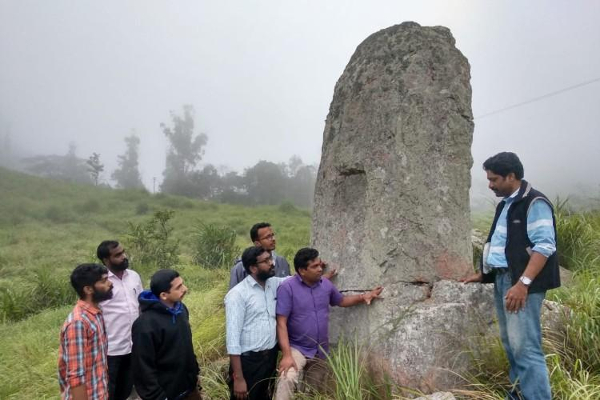An archaeological exploration at Chakkakanam hill, near Nedumkandam, on the eastern side of the Western Ghats, has yielded petroglyphs (rock carvings) similar to the ancient Indus scripts on Megalithic-era menhirs, a rarity in south India. Thirty-seven menhirs, some of them fallen, were found in four sites on the hill. Petroglyphs were also found on a huge rock.
Individual studies earlier had found burial urns, dolmens and ancient instruments in the area pointing to its connection to the Megalithic era. The latest discoveries highlight the importance of further studies to unravel those ancient days when the hills were a safe area for settled or nomadic tribes.
K.K. Muhammed, former director, Archaeological Survey of India (ASI), said petroglyphs had been found on menhirs or cists for the first time in Kerala. However, there were such inscriptions on huge rocks at the nearby areas of Ramakkalmedu and Thookkupalam.
Link between scripts
The finding of petroglyphs on menhirs has to be linked to the archaeological excavations at Keezhadi on the Vaigai valley at Theni district in Tamil Nadu. The descriptions on the rocks, which resemble the Indus scripts, have to be studied to find their link to the Dravidian scripts, said Rajeev Puliyoor, a member of the exploration team. According to the studies of epigraphist Iravatham Mahadevan, the ancient Dravidian scripts have a link to the Indus scripts or might be older than the latter.
A deeper study would give valuable information on human relationships with animals and the form of worship during those days, Mr. Puliyoor said. The inscriptions and the petroglyphs are believed to be around 3,000 years old.
Efforts to bring expert
“There are many historically important remains on ruin and they needed to be protected,” he said.
The findings had been conveyed to the ASI and efforts were on to bring archaeologist Vasanth Shinde, who led the Indus Valley excavations, he added. The exploration was conducted by a team from the College of Teacher Education, Nedumkandam, comprising Mr. Puliyoor, M.S. Jayan, and Rison P. Joseph.
Source: TH
Image Courtesy: The News Minute
You may also like
-
India Can’t Afford to Remain Stagnant at this Juncture, Says PM Modi; Asks People to Buy Locally-Made Goods
-
Stolen Artefacts to be Returned to India from Scotland Museums
-
Legendary Singer Lata Mangeshkar Passes Away At the Age of 92
-
Netaji’s Hologram Statue at India Gate
-
10th Century Stone Idol of Goat Head Yogini IllegallyRemoved from A Temple in Lokhari, Banda, UP Being Returned to India
